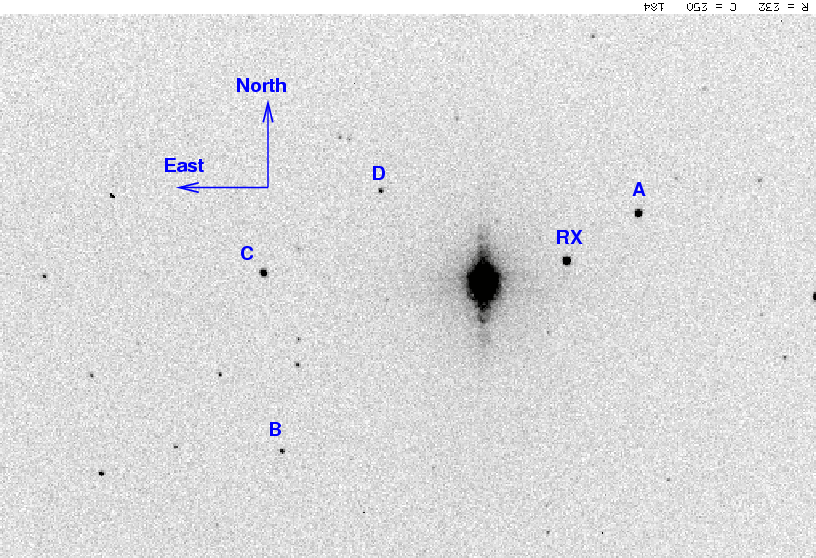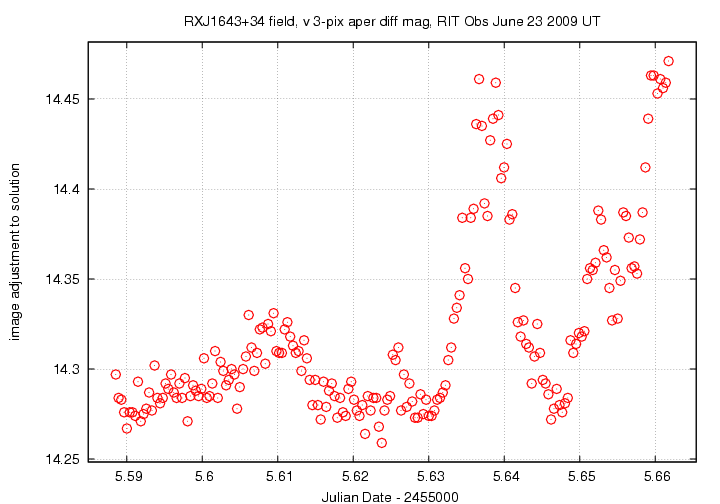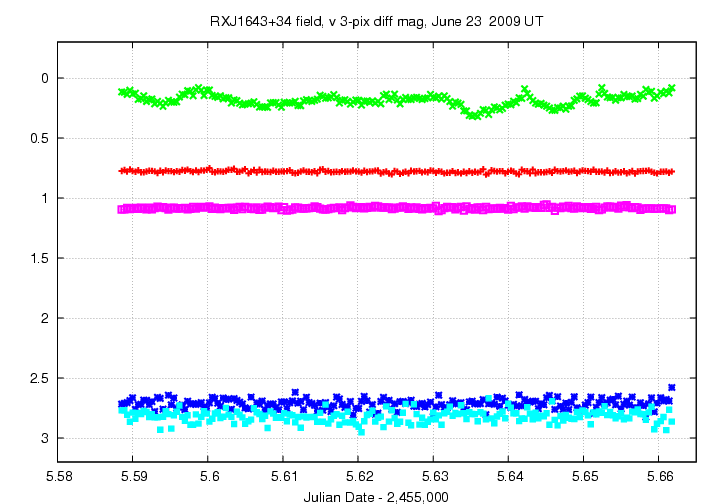
On the night of June 22/23, 2009, I observed the cataclysmic variable star RXJ1643+34 = V1084 Her. Joe Patterson of the Center for Backyard Astrophysics suggested that members of the CBA observe this star during the summer.
The object is at RA = 16:43:45.70 Dec = +34:02:40, so it is placed near the meridian at sunset. I'm still learning how to use our new 14-inch Celestron telescope on the Astrophysics mount, and it appears that there may be a small annoying break required to move the telescope from one side of the German equatorial mount to the other during the night.
The setup was:
Notes from the night
This is a chart of the field taken from the DSS.

The chart has several of the brighter stars in the field labelled with letters, just to keep me straight as I perform the reductions. Star A is photometry provided by Mickaelian et al., A&A 381, 894 (2002):
my label RA Dec B V ---------------------------------------------------------------------------- A USNOB1.0 1240-0246555 16:43:40.59 +34:03:02 13.51 12.97 ----------------------------------------------------------------------------
I measured the instrumental magnitude of each star with aperture photometry, using a radius of 3 pixels = 4.2 arcseconds and sky defined by an annulus around each star. Following the procedures outlined by Kent Honeycutt's article on inhomogeneous ensemble photometry, I used all stars available in each image to define a reference frame, and measured each star against this frame.
One output of the ensemble solution is the value of the zero-point of each frame relative to the others. In the graph below, I plot this zero-point as a function of time. The sharp rise near the end of the run is caused by dew on the corrector plate.

Below is a graph of the scatter in differential magnitude versus magnitude in the ensemble solution. There are two stars ("A" and "C" on the chart) at differential mag 0.8.

The floor of this diagram corresponds to a scatter of about 0.008 mag. RXJ1643 appears at differential magnitude 0.2; its scatter of 0.050 mag is much larger than that of other bright stars. showing that it is a variable.
Light curves for selected stars (RXJ1643 and stars A - D) in the field are shown below. The target is shown by light green crosses. I've shifted star "C" (pink squares) a bit to separate it from star "A" (red plus signs).

Here's a closeup of the variation in RXJ1643 and a few comparison stars.

I've made a table of the measurements themselves, with three different flavors of time. The differential magnitudes from the ensemble solution have been shifted so that star "A" in my chart, USNOB1.0 1240-0246555, has value 12.97.
Here's the start of the table.
# Measurements of RXJ1643+34 made at RIT Obs, Jun 23, 2009 UT, # by Michael Richmond. # Each exposure 20 seconds long with V filter. # Tabulated times are midexposure (FITS header time - half exposure length) # and accurate only to +/- 1 second (??). # 'mag' is a differential magnitude based on ensemble photometry # using a circular aperture of radius 4.2 arcseconds. # which has been shifted so USNOB1.0 1240-0246555 has V=12.97 # to match value from Mickaelian et al., A&A 381, 894 (2002) # # UT_day JD HJD mag uncert Jun23.08855 2455005.58855 2455005.59141 12.306 0.009 Jun23.08891 2455005.58891 2455005.59177 12.309 0.007 Jun23.08928 2455005.58928 2455005.59214 12.327 0.008
Last modified 6/23/2009 by MWR.